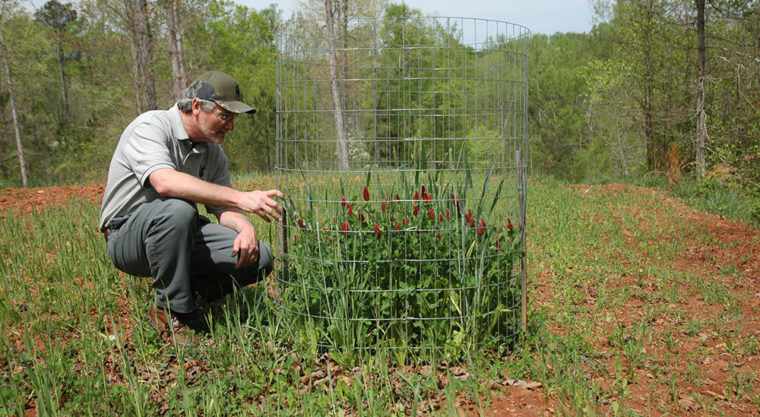Often, food-plot farmers complain about crop failure because nothing seemed to grow in the field they planted, especially in small plots. The plants germinated fine but never grew more than an inch or two. While it appeared that the crop failed, often the culprit is deer browsing the crop so heavily that the plants never stood a chance. This is where a browse exclosure, also called a utilization cage, is important. A browse exclosure is a simple, wire exclosure that prevents deer from feeding in a small portion of a plot. The crop can grow inside this cage without browse pressure, providing a visual gauge of pressure outside the exclosure.
If the crop inside the cage is lush, tall and thriving, while outside the cage there is only crop stubble, weeds and deer turds, you probably have too many deer for your current habitat conditions. To solve this problem, you should increase food plot acreage, take steps to improve native habitat, or buy more bullets. Most likely, a combination of all three would help.
The ideal result is to see light to moderate browsing outside your cages. Deer are using the food source, but there is enough food in the local area to go around, so overbrowsing of plots is not an issue.
If you see no indication of deer browsing the crop, it doesn’t necessarily mean local deer don’t prefer that crop. Competing food sources may be abundant. Wait for a change in the weather or native forage conditions to lure deer to your plots. If this never happens, consider trying a different crop, or have the soil tested to ensure nutrients are at adequate levels for the particular crop.
Here’s how to build a food plot browse exclosure:
- Select 4-foot-high welded wire fencing with 2×4-inch panels.
- Wearing gloves and using wire shears, cut the fence into 10-foot long sections. Each 10-foot long section will form one browse exclosure. When cutting through the horizontal wires, make the cut close to the next vertical wire, leaving tag ends of horizontal wires projecting.
- Roll the section until the ends connect to form a cylinder. Bend the tag-end wires of one end around the vertical end wire of the opposite end, forming loops that attach the ends of the rolled cage together.
- Drive sturdy stakes of rebar or wood into the ground on opposite sides of the cage and secure the cage to the stakes with wire ties. Or, “weave” the stakes through at least three panels near the bottom of the cage by bending the panel wires slightly, then drive the stake into the ground. The cage should be secure enough to withstand wind as well as animals pushing against it.
These tips are taken from NDA’s comprehensive book Quality Food Plots, one of the top selling books ever published on food plot management.
